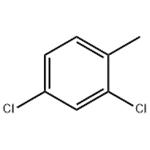Chemical Properties
It is a clear colorless liquid that is insoluble in water but can be mixed with ethanol, ether, and benzene. It is primarily used as a pesticide and pharmaceutical intermediate, but also serves as a solvent.
Uses
2,4-Dichlorotoluene was used as an oxidant and a solvent during anaerobic catalytic oxidation of secondary alcohols by using an
in situ (
N-heterocyclic carbene)-Ni(0) system. It was used as growth supplement in the culture media of
Ralstonia sp. strain PS12. It was used to develop a sensitive method based on solid-phase microextraction followed by gas chromatography-tandem mass spectrometry for the analysis of chlorotoluenes in water samples.
Preparation
2,4-Dichlorotoluene is synthesized by diazotization and chlorination with 2,4-diaminotoluene as raw material. First, hydrochloric acid and water into the reaction pot, heated to 50°C, stirring under the dissolution of 2,4-diaminotoluene, then hydrochloric acid and cuprous chloride into the pot, the 1% sodium nitrite solution evenly added, the temperature is maintained at about 60°C, resting stratification, the lower layer of crude product washed with water to neutral, add alkali to alkaline, and then water to remove the alkali, divided 2,4-dichlorotoluene crude product, water distillation of finished products.
Definition
ChEBI: 2,4-Dichlorotoluene is a dichlorobenzene.
General Description
Clear colorless liquid.
Air & Water Reactions
Insoluble in water.
Reactivity Profile
Simple aromatic halogenated organic compounds, such as 2,4-Dichlorotoluene, are very unreactive. Reactivity generally decreases with increased degree of substitution of halogen for hydrogen atoms. Materials in this group may be incompatible with strong oxidizing and reducing agents. Also, they may be incompatible with many amines, nitrides, azo/diazo compounds, alkali metals, and epoxides.
Purification Methods
Recrystallise 2,4-dichlorotoluene from EtOH at low temperature or fractionally distil it. [Beilstein 5 IV 815.]





